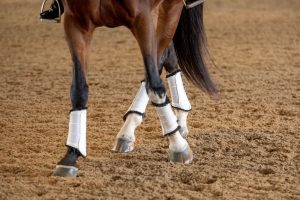 You come out to ride, you groom, you tack up, you hop on… and your horse is lame. What do you do? You certainly can call the vet right away, but there’s a few things I like to rule out first, when I encounter a mild lameness.
You come out to ride, you groom, you tack up, you hop on… and your horse is lame. What do you do? You certainly can call the vet right away, but there’s a few things I like to rule out first, when I encounter a mild lameness.
First, I like to check for my favorite problem: acute foot pain. Dismount and check your horse’s feet. Did he step on a rock? (By the way, this is why you should pick your horse’s feet like Al Capone voted: early and often) Take out hoof testers, and put them to good use. Is there heat in the foot? Any discoloration? Is the shoe on correctly, or has he stepped on a nail? It’s a good starting place, and if you don’t know how to check out a foot, make sure your vet or farrier shows you next time you’re in their company.
On that note, you need to know when your horse was last shod, because if he comes up tender a day or two after shoeing, you could be dealing with a hot nail, a nail that was driven into the soft interior of the hoof instead of the exterior, which has no pain receptors, like our hair or fingernails.
If you’ve ruled out the foot, time to check up the leg. Skin irritations or “crud,” like scabs from dermatitis, can really irritate. If your horse has some crud, and is also wearing boots or wraps, pull the boot or wrap off and see if he’s sounder. I’ve had horses act like they had a broken leg simply because his skin hurt when rubbing against a soft polo wrap, poor delicate flower.
Swelling is the same – sometimes a horse gets a teeny tiny cut and it blows the whole leg up. Check for those sorts of things, and make sure to also take your horse’s temperature. A puffy leg plus a temperature can mean a serious infection, and your horse could need veterinary attention right away.
The last thing I check is for back pain. A lot of horses can experience lameness of limb because they’re trying to guard their backs or necks, which can hurt because of a myriad of reasons, including saddle fit, blanket fit, or just straight up hard work.
If there’s no obvious wounds, cuts, swelling, heat or scabs, no obvious foot pain, no obvious source of injury, you get to choose how much of an alarmist you would like to be. Unless I have a horse with an important outing on his event horizon, I like to take the Very Scientific Approach of waiting three days. I recently rolled my own ankle while undertaking a very serious and complicated athletic endeavor – walking on flat ground in appropriate shoes – and I figure if I’m that clumsy on two legs, a horse is capable of being that clumsy on four. A few days of “tack walking” for me, where I rode and strolled around and did not much else, and I was good as new.
So I give my horses the benefit of the doubt. Maybe they’re sore and tired from training hard, maybe they slept funny, maybe they spooked in the field overnight and tripped and tweaked something. I personally don’t use NSAIDs to get through these timeframes, because I don’t want to mask anything more sinister. But I know others who do, and that works for them. I don’t think there’s a hard and fast wrong answer.
And it’s amazing how many come around the very next day, or maybe a day after that.
Of course, when things don’t resolve, I’m the first one in line at the vet’s office, using a quality sports medicine vet to guide me through the steps on whatever comes next. But I’ve never ever regretted a few days off for one of my horses out of an abundance of caution, and it’s often just what the doctor ordered.
Are you liking Snippets, my little bonus blogs? They began because I had all these little ideas for blogs that maybe weren’t long enough to be proper content for COTH, or weren’t horsey in nature. So they’re here. If you like them, leave a comment to let me know you’re seeing them. And if you like hearing EVEN MORE from me, consider joining the Sprieser Sporthorse Elite Club! Your membership – for as little as $.25/week – helps me keep producing things like this, as well as all the special content Club Members get to see.